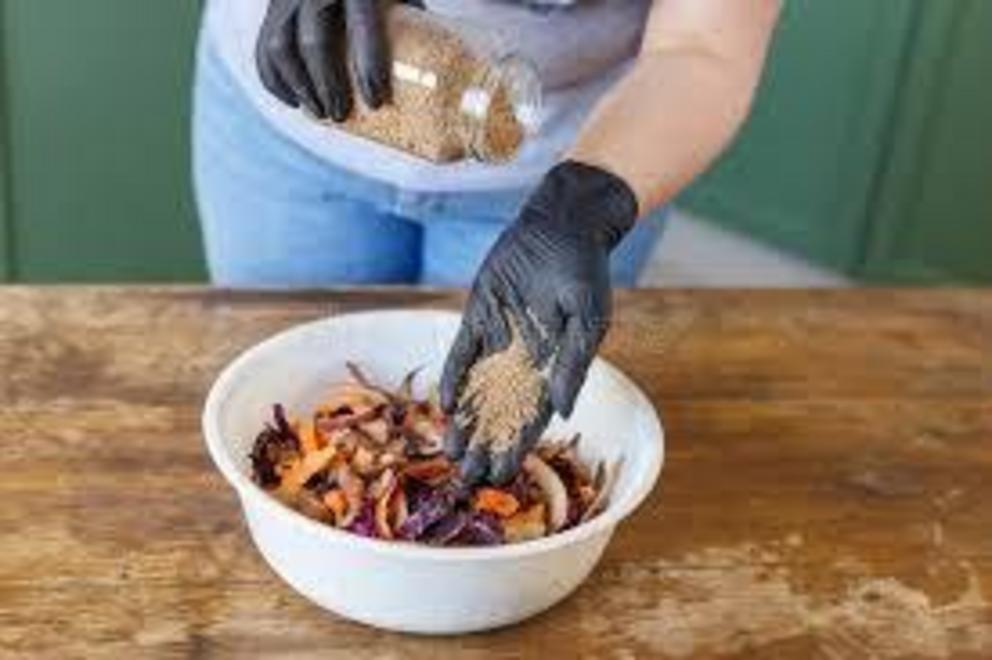What is bokashi composting?
Bokashi is a unique method of composting and fermentation with roots in traditional Asian farming practices. It uses a mix of organic materials and effective microorganisms to increase microbial turnover in compost and soils. Subjected primarily to lactic fermentation, organic waste processed in this manner is used to enhance the soil and improve crop quality.1
Bokashi has become increasingly popular in the United States due to its practicality and effectiveness. Unlike other types of composting that require large bins or outdoor space, bokashi only requires a bucket and a few other simple tools, can be done in small indoor spaces, and the necessary effective microorganisms can be easily purchased.
The technique first became popular in Japan in the 1980s, when Dr. Teruo Higa began promoting his combination of effective microorganisms for bokashi, but the process of fermenting organic waste for composting has been practiced across Asia for centuries. Recently, scholars have suggested that producing fermented liquid for fertilization first happened in India, with texts dating back to the year 1000 A.D. mentioning kunapajala (filthy fluid) or kunapambu (fermented filth).2 Bokashi also has ties to ancient Korean and Japanese farming techniques, in which fermentation provided a way to safely break down meat and dairy scraps that could contain pathogenic microbes.3
How Bokashi Works
Japanese scientists developed effective microorganisms in the 1970s at the University of Ryukyus in Okinawa, where Dr. Higa discovered that microbes can coexist in mixed cultures and be introduced into the natural environment, and that the individual benefits of each microbe are magnified when combined with compatible microbes. These combinations of effective microorganisms introduced to organic materials and subsequently fermented produce bokashi.4
Fermentation is fundamentally an anaerobic process, since the microbes responsible for fermenting organic materials function without oxygen. Therefore, most at-home or small-scale bokashi efforts require a sealed container to store food scraps.
In the United States, bokashi typically starts as a mix of food scraps and bokashi inoculant — a combination of effective microorganisms, water, and molasses mixed into wheat and bran that can be purchased already prepared. Left to ferment for 2-3 weeks, the mixture produces a leachate (commonly called bokashi tea) containing organic acids, alcohols, and other metabolites accumulates that need to be periodically drained to maintain microbial activity. After fermenting, the bokashi mix is buried underground for two weeks, during which it further degrades and releases nutrients.5
Tools for Bokashi
What makes bokashi unique compared to other methods of fermenting waste is the use of effective microorganisms. Bokashi inoculant is widely available online on its own or as part of bokashi starter kits. You can also DIY bokashi bran, though you'll still need to purchase effective microorganisms.
In addition to the inoculant, bokashi composting requires an air-tight container with a sturdy lid for anaerobic fermentation, opened only to add food scraps and bokashi bran in layers. The container should have a strong spigot at the bottom to periodically drain the bokashi tea. The fermented material inside can be added to an outdoor compost pile or buried in soil in as little as 10 days. Some people keep a plate inside their fermenting vessel to press down the organic waste, which helps move leachate to the bottom to drain and prevents oxygen from reaching food scraps.
Why Bokashi?
Currently, food waste makes up about 40% of municipal solid waste in landfills across the United States. This waste has been shown to contain hazardous pathogens, with around 80% of solid food waste containing fecal coliforms, according to an EPA study.6 A shift away from throwing food scraps in the trash and towards bokashi would mean not only the elimination of solid food waste from landfills, but also less hazardous pathogens potentially leaching into waterways and agricultural areas. Traditional composting also means less food waste, but composting materials like meat and dairy require high heat and significant maintenance, whereas meat and dairy scraps are easily fermented and safely added to the soil with bokashi.3
Fermentation vessels for bokashi take up a small space indoors and don't require mixing green and brown materials like compost does. It can be done cheaply and with minimal effort.
Because bokashi is produced in a sealed jar, it creates less odor than traditional composting, and also allows for easy collection of leachate from the fermentation vessel, which contains significant levels of dissolved organic and inorganic compounds. This liquid, known as bokashi tea, is both valuable and potentially hazardous, as it could pollute drinking water sources if allowed to run off-site in agricultural settings.3 In controlled settings, such as home bokashi compost, the leachate can be used to fertilize plants and enrich the soil. It can also be safely disposed of in the drain if you're part of a municipal sewage system.
To be fully certain your bokashi tea will work with your specific plants, you can add it to soil and have a sample sent to your local agricultural extension to be analyzed. It's important to have some idea of what elements you're adding to the soil, as well as the ideal elements and concentrations for the plant.
For the rest of this article please go to source link below.
For full references please use source link below.

